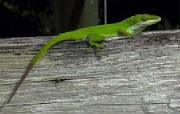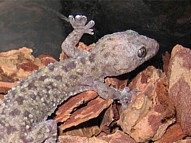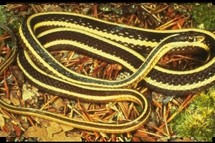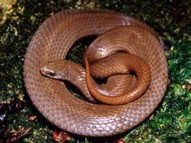|
Green Anole
Anolis Carolinensis

|
They hibernate in the winter but after that you see them everywhere. They love to sun and the male has a red throat fan or
dewlap we call a 'money bag' that he flashes to stake his territory from other males and attract females. It's a common misconception
this anole is a chameleon because it changes color from green to brown in various shades but chameleon is just a common name
for it. They belong in the Polychrotidae family (anoles) in the suborder of Iguania. It prefers to be green but browns to
match a darker background like bark, in hibernation stage, or when it has become ill. They do well as pets but prefer a tall
vivarium with 80-90, well ventilated humidity with tall pieces of bark as a hide. A screen lid would be better for them with
UV or full spectrum fluorescent lighting and an under the tank heater on the side of the tank though they also do fine in
room temperatures and don't need much at all to warm up or be comfortable. They can live in a ten gallon tank but I wouldn't
put more than two. Males do not mix.
|
|
Ground Skink
Scincella Lateralis

|
Very common in my backyard. They mostly like to be under things like wood, stone and dead leaves. It's rare to see them without
disturbing something and could be mistaken for a snake at first because they're shiny and slick.
|
|
Mediterranean Gecko
Hemidactylus Turcicus

|
Very common introduced gecko are the Med. House Gecko's from India to Turkey. They have nearly transparent skin with grainy
speckles and can't blink their eyes so they lick them and they make a small barking noise. They come out only at night like
under my porch light. They prefer soft/smooth, wood like smooth sided bark, uncrumbled cork, planks in a garage, between panels
or in the walls of a house or even wood and compost piles. For the most part they like to live somewhere slightly damp but
not too dry.
|
|
Red Eared Mud Slider
Chrysemys Scripta Elegans

|
Very unlikely I'll find one wandering into my back yard but you can find them in almost every park, cow pond, lake or creek
you ever go to. They start out as cute, tiny little babies, but they grow up to be as much as a foot and sometimes even a
little bit bigger.
|
|
Ribbon Snake or Garter Snake
Thamnophis Sauritus

|
Ribbon snakes get pretty big but they're not poisonous. They'll bite if they feel threatened while you're handling them so
be nice. They'll eat the mice for you. Most of the one's I see around my yard like the raised beds and compost pile.
|
|
Earth Snake or Ground Snake
Virginia Valeriae

|
Identifying the ground snakes around here is proving difficult online. I'm very sure I have a positive I.D. there or they
could be Sonora Semiannulata, but so far no pics look as simular. The ground snakes are pretty small and always up under something
like stones and around raised beds. They're a bright brown, usually with a slightly light strip just like the picture shown.
Harmless and passive.
|

